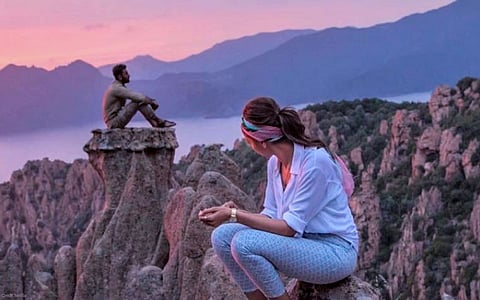
- In-Depth Stories
- Web Stories
- Reviews
- News
- FC Lists
- Interviews
- Features
- FC SpecialsFC Specials

A great movie image is not just a pretty frame. They convey a bigger picture, have ideas, and use the visual medium to the max. We picked 10 images we love from Indian cinema of the past decade:
At first it might seem like the Corsica portions of Imtiaz Ali's Tamasha are purely cosmetic – beautiful locales, dreamy views. But one striking frame (the lead image above) foretells Ved's internal conflict. It's a famous frame – Tara in the foreground watching Ved, and Ved watching the sunset seated alone on a ledge in the background. For the rest of the film, Tara watches as Ved wrestles between his crippling foreground (9-to-5 life) and his hidden artistic background (storytelling).
The fire blazing behind them is the rot of the harvest, but the obvious metaphor of it being the incinerated world that they foreground, of deep caste bias, is hard to miss. That this comes up in the moment of escape towards the big city, where caste might be less of a solid construct, is telling.
Few films made today are shot in black and white, fewer still exploit the medium as much as Ronny Sen's Cat Sticks. Set in the kind of abandoned, closed space that crack addicts prefer, the image above uses shape, form, shadows, line and smoke to create a picture of a haunting and mysterious quality.
In Kadal, it's when Tomas (Gautham Karthik) switches to a life of crime that he's asked to help Beatrice (Thulasi) with a delivery. As his life plummets more and more towards evil, he finds his hands painted red with blood again but not the kind that makes one guilty. He realises that blood can be spilled in the pursuit of creation and not just destruction. For a brief second, in that realisation, Thomas becomes Jesus himself.
The adventures of Khalujaan and Babban get a twist in this sequel, where the conmen get conned by their own male gaze. Emblematic of this twist is a beautifully conceived frame in which – after the women Begum Para and Muniya, otherwise the mistress and maid, are reunited – we see the shadows of their joy reflected on the wall behind Khalujaan, dwarfing him. The lesbian subtext, inspired by Ismat Chughtai's "Lihaaf", dawns upon the two men just as it so aesthetically dawns on the viewers of the film here.
If there's one shot we can classify under a sub-section called "Mallu Still Life" it would have to be the image of Mahesh's spotless chappals, the two fruits in between and his freshly washed undies, with the man himself in the background. So simple yet primal in every way. It foreshadows the film's story of embarrassment and how it leads a man to swear off his chappals until he gets his revenge. It tells you more about the character than pages of exposition and it's also a thing of great beauty.
Appropriately for a film that's about adolescent isolation and displacement, Avinash Arun's Killa is composed of gorgeous overcast frames of the Konkan coastline. In most of them, the teenage protagonist Chinmay is tiny and alone, as if engulfed by the natural loneliness of his new world. This particular shot, however, has Chinmay peeking out of a fort ("Killa") on an excursion with his classmates. He's happy and free, and the image of the three empty windows to his right signifies that even his best moments are missing human company. The shot also visually reveals that, unbeknownst to Chinmay, the others have abandoned him at the gloomy fort.
Ranveer Singh's Murad, an aspiring rapper from Dharavi who is frustrated with his small-time life, works as a driver for a rich family. In this allegorical frame, Murad waits in the car on New Year's eve, while the star-lit parking lot bathes his shiny window panes in its reflection – creating an illusion of a spotlit stage calling out to its future star. This is all the shining he can do for now.
Calling this composition 'beautiful' might be a bit of a stretch but this image is worthy of a thousand laughs. A man so big he can barely fit into his own coffin. But it's the angle that makes it so blatantly funny. With his elbows sticking out, he resembles the cross he's holding. We barely know the man. We don't even see him, yet his excesses become obvious. The woman that's bawling over him isn't even his real wife.
It's the moon…It's a planet…It's the close-up of mustard oil, in all its glorious goldenness, being poured into a saucepan in order to cook fish curry. To see something so domestic being projected on a big cinema screen was hypnotic. Aditya Vikram Sengupta's film, about a working couple who hardly meet due to different shifts, revels in such details.